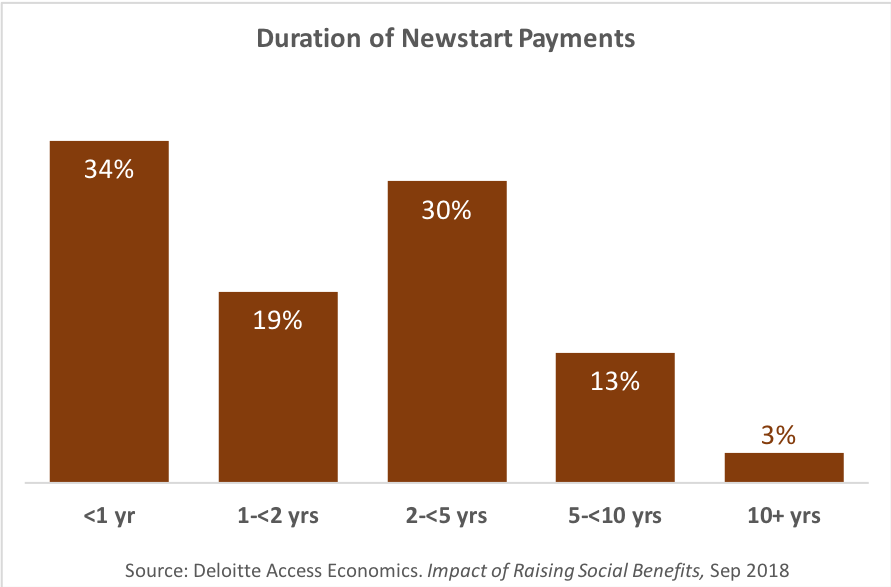How would you fare if you had to live on Newstart (the dole)?
I ran the Centrelink income calculator and discovered that if Sandy & I were unable to find work we would be eligible for $630.00 per week. That’s made up of the Newstart allowance, Family Tax Benefit (we have two children living at home with us), and an energy supplement. Could our family live on that?
At first glance I thought it would easy for the four of us to live on $630/week. But when I started doing the sums I found it quite challenging.
First up, we would need to make savings by getting get rid of some big ticket items: cancel our health insurance; switch Lachlan from private to public schooling; and sell our newer car, use the money we get from that to finalise an outstanding loan, and keep our 12 year old Kia Rio.
Yet when I punched these savings into a spreadsheet we were still some distance from living within the $630 per week of the dole. Somehow we would need to find a way to make this cover:
- mortgage payments (and by Australian standards our mortgage is very modest);
- home and content insurance;
- motor vehicle registration, insurance, petrol and servicing;
- land, water and electricity rates;
- health costs;
- clothing;
- haircuts;
- groceries and other consumables;
- school costs;
- phone and internet.
We might, with a lot of discipline, just get there if we negotiate with our bank to make interest payments only; cancel the phone plan of each member of the household in favour of a shared family mobile on a very cheap plan; cut our internet back from high speed, unlimited data (I have children who game!) to the cheapest plan on the market (thus upsetting children who would no longer be able to game); find ways to use less electricity; eat cheaper foods; and make more stuff ourselves. We would not be able to buy the kids gifts for their birthdays or Christmas, pay for a holiday away from home, or afford to eat out or go to the movies. Lachlan would need to get an after-school job to pay for his recreational expenses. And we’d be hoping that there would be no unexpected big expenses (eg fridge needing replacement or major repair costs on the car) for there would simply be no money to pay for these.
That it would be difficult to live on Newstart should come as no surprise, for close to 80% of households that rely on the Newstart payment live below the poverty line.
The rates of Newstart Allowance and student payments fall well below the poverty line and are not enough to cover the cost of essentials. These payments have not kept pace with rising living expenses and, unless they are increased and properly indexed, will slide even further behind…
The inadequacy of Newstart and Youth Allowance is having devastating effects on individuals, families & communities: deepening inequalities, robbing people of their dignity, and undermining the health and wellbeing of families
St Vincent DePaul Society, Briefing on the Newstart Allowance
Housing stress can be one of the ways families are robbed of their dignity on Newstart. To begin with it is extremely difficult for many living on Newstart to find a place to live. Anglicare surveyed the private rental market and found that of 69,000 private rental properties available across Australia, only two were affordable to a single person on Newstart. This means that households dependent on Newstart often have to spend so much on rent that “they can’t afford to eat decent food, fill a prescription, pay for transport, or buy clothes.” (Anglicare, April 2019, Rental Affordability Snapshot, page 17).
The Business Council argues that not only is the current level of Newstart indecent, but because it leaves people less healthy, less likely to be housed in areas where there are jobs, and unable to afford the cost of clothing and transport required for job interviews, that it impairs people’s ability to reenter the workforce.
These realities are borne out in the stories told by people living on Newstart.
“You can’t live on Newstart. I eat one meal a day so the kids can eat. My sweet girl says I should eat more. I was a nurse for 27 years. All my savings have gone. I’m in so much debt. I try my best but feel so ashamed.”
Ellen, 61 and caring for two children. Story told in ACOSS 2018 Poverty Report
“I’m 51, on Newstart and need someone to know what I’m experiencing. I’ve been homeless this year, and last. I’m reliant on my daughters giving me extra food when they can. I lost my car. What I’m afraid of is if this nightmare continues”
Bella. Story told in ACOSS 2018 Poverty Report
I was on Newstart from October 2017 until April 2018 and it was impossible to meet basic expenses such as rent/food/bills, never mind new clothes and transport.
Jim. Story told in ACOSS 2018 Poverty Report
25 years of unbroken economic growth have seen Australians get vastly richer. Collectively we enjoy a standard of living unrivalled in history. Yet while our economic success saw Australian wages, profits and government benefits surging upward, every Government since john Howard’s has made sure that this didn’t apply to payments to the unemployed. Since 1999 increases in the Newstart allowance were pegged to inflation. As a result the single Newstart rate today is equivalent to only 60% of the age pension and 38% of the minimum wage.
NEWSTART COMPARED TO OTHER PAYMENTS (2017)
| NEWSTART | AGE PENSION | MIN WAGE | MEDIAN WAGE |
| 267.80 | 437.10 | 694.9 | 1405.00 |
Observing the gulf between Newstart and the minimum wage, Chris Richardson, Senior Partner in Deloitte Access Economics and an economist frequently consulted by Coalition governments, commented that
“[W]e here in Australia don’t have a dole-bludger problem — what we have is a society that is unnecessarily cruel.”
Chris Richardson, Access Economics
Richardson points us to the awful recognition that we have organised our society so that those who cannot find employment are punished. We have been and are being cruel. And we have crafted a mythology that justifies this cruelty. This is the mythology of the “dole bludger”. We have somehow convinced ourselves that the fruits of our hard work are being taken from us by hordes of lazy dope-smoking young people who have never worked a day in their lives but just want to party without end funded by our taxes. Our mythology is buttressed by sage pronouncements that anyone in this country who wants a job can get one if they’re prepared to work hard, and repeated tales of young people who refuse a job because it is beneath their dignity and of employers who advertise but cannot find anyone to work for them. Those thieving-lay-about-wouldn’t know-an-honest-day’s-work-if-it-walked-up-to-them-and-slapped-them-in-the-face-dope-smoking-hippy-delinquents deserve nothing from us other than a kick up the backside…and perhaps that’s what making their lives as difficult and miserable as possible might just do.
The reality is that there are not plenty of jobs out there for anyone prepared to work hard. It is a simple statistical fact that there are fewer jobs available than there are people who are unemployed. In May 2018 for example, there were eight unemployed or under-employed people for every job vacancy. Add to this the people who are already employed but looking for a change and it is not uncommon to have 15-20 people seeking a job for every job that is advertised.
This means the ranks of the long term unemployed are not filled by dope-smoking-lazy-youth, but rather with people lacking occupational skills or who employers discriminate against: those workers who are older (in 2017 49% of the long term unemployed were over the age of 45); principle carers of children (16%); people living with disabilities (29%); people with Aboriginal and Torres Strait Islander background (11%), and those with culturally and linguistically diverse backgrounds (21%). It is people like these who are long term unemployed and are being crushed by the grinding reality of poverty level unemployment benefits.
It’s exceedingly rare that unions, social service organisations, business councils, former Liberal and Labor PMs agree on issues regarding social welfare and the labour force. Yet there is an extraordinary consensus that Newstart payments need to rise. The most often cited suggestion is an increase of $75/week and then ensuring that in future Newstart is increased in line with other social welfare payments.
How then do we make sense of the steadfast refusal of the PM and the Treasurer to countenance an increase? They and other members of the government repeatedly trot out two responses.
“We’re not changing Newstart and the reason why is Newstart recipients, 99 per cent of [them] receive other benefits, so it might be a parenting benefit or another benefit…
“The other thing about Newstart is two-thirds of the people on Newstart move on to a job within 12 months.”
Josh Frydenburg, Treasurer, cited by ABC News
Neither response amounts to an explanation.
“People on Newstart receive other payments“
This is true, but the way it is articulated to suggest that these other payments compensate for the low rate of Newstart is misleading. Everyone on Newstart receives an energy supplement allowance, which for a single person without children is $4.40 per week. In particular circumstances Newstart recipients may also be eligible for a telephone allowance (maximum rate is $43.80/year or 0.84 cents/week) and a pharmaceutical allowance ($3.10/week). There are two more substantial payments that some receive: Family Tax Benefit which 19% of Newstart recipients receive and rent assistance, which 32% of Newstart recipients receive. (Data sourced from the Conversation)
But pointing to these other benefits doesn’t resolve the problem. These extra payments are made in recognition that the person receiving them incurs additional costs above those provided for in the Newstart allowance. And those payments never come close to funding the full amount of those extra costs. The result is that even when receiving the maximum rates for Newstart and other payments, the total benefit households receive places far below the poverty line.
GAP BETWEEN MAXIMUM BENEFITS AVAILABLE TO NEWSTART RECIPIENTS AND THE POVERTY LINE (2017)
| HOUSEHOLD TYPE | MAXIMUM PAYMENTS | AMOUNT BELOW POVERTY LINE |
| Single, no children | $324-$331 | $105-$191 |
| Couple, no children | $529-$599 | $85-$215 |
| Single, 2 children | $595-602 | $93-$232 |
| Couple, 2 children | $751-$767 | $85-$215 |
Source:ACOSS Poverty Report 2018
“Two-thirds of the people on Newstart move on to a job within 12 months”
The point Frydenburg and other are seeking to make is that Newstart is not meant to be a permanent source of income replacement but a stop-gap to help people while they are inbetween jobs. As such it was expected only to supplement other sources of income for the short period of time people were out of work.
But the reality is that large numbers of people receive the payment for long periods. 2/3 of those who receive Newstart allowances remain on them for more than a year, including almost 50% who remain on Newstart in excess of 2 years.

Newstart may not have been designed with long-term recipients in mind, but it has become a means by which the Government distributes benefits to the long-term unemployed, and therefore must be managed in a way that recognise it is the primary source of income for hundreds of thousands of people for the medium term and to a lesser degree the long term. This is precisely why the rate needs to be lifted.
We can raise the Newstart rate
The arguments offered by the Government are weak and fail to offer defensible grounds for its refusal to budge.
Nor are there economic grounds for inaction. Last year Deloitte Access Economics released a study of the costs and benefits of a $75/week increase in the Newstart Allowance. It found that it would cost the Government $3.3 billion a year and would have both a “prosperity dividend” and “a fairness dividend”. The “prosperity dividend” would a boost the economy by $4 billion and create 12,000 jobs in the first year but would fade over time. The fairness impact would be substantial. The bottom 20% of income earners would receive a boost to their income 28 times the relative boost to the top 20% of income earners.
The continued refusal by the Government to lift the Newstart allowance is particularly galling to me in view of its commitment to deliver $300 billion in personal and company tax cuts and to invest $100 billion in infrastructure over the next ten years. Lifting the Newstart payment is endorsed by major business groups, unions, community service organisations, churches, former PMs, and many more. All agree it would have an immediate and dramatic effect on the wellbeing of around 700,000 Australians. It would reverse decades of injustice and would be welcomed across the political spectrum.
Dear Prime Minister, what on earth is holding you back?








Ah, thanks so much, Scott,
And there’s the compounding, interlocking injustices here. From my experience and knowledge the extra support and contributions that people on various benefits (‘helps’ I ‘ve seen them called) come from others on various benefits, and the spiral is downwards. Several people who can’t meet reasonable living expectations join together – and postpone the crash when accumulated resources have all been consumed. So, for example, parents on a pension provide sacrificial support for younger family on NewStart – to a point where there is nothing left to trim in either household. Woe betide if a major illness or death strikes in that situation!
The hidden underclass-building that therefore happens through familial responsibility and compassion is, I am convinced, generationally tragic.
And when I hear the slogans “If you have a go, you’ll get a go!”, “These benefits were not intended to a living wage.” “You must be prepared to move in order to get a job.” and others, I think ‘Out of touch’, and also ‘No wonder the “asylum seekers” get such a bashing.’
Well maybe Lachlan should get a parting job – why not ??? and you and Sandi have a tertiary high level qualifications . You all have the skills to prevent the his from being long term issue. To be honest you are all well educated and in a good position. I don’t think tax payers money should pay for private school education – sorry I think you as an educated well off family is not a good example of what you are saying
Hi Libby I think you have read the opening section of my article in a way it wasn’t intended . I wasn’t suggesting taxpayers should pay for private school fees nor that Sandy and I are without opportunities due to tertiary education nor that in the situation described Lachlan shouldn’t get a job. The first part of the article was simply an attempt to imagine how we would survive if we didn’t have access to the things education, privilege, opportunity have brought us and we found ourselves without work for a substantial period of time.
Moreover the argument of the piece is not that everyone should be supported to have everything they want but that Newstart should be sufficient that people do not need to live in poverty. They should be able to afford to rent a place to live, eat 3 meals a day, clothe themselves, get medical care, etc.
People living in this situation like yourselves as the example would have to go hopefully only a short time without some of the things you have listed in your household expenses eg a new car, school fees, health insurance, the highest level internet, going away on Christmas holidays, buying new clothes. To me these are all extra things that are not the be all requirements to live. I don’t think as a society we should be funding these things. I do agree that Newstart should be enough to be able to live and have the basic necessities whilst getting back on your feet. I do believe it should ensure that people have a chance to find work which can provide them with the opportunity to have savings and spend money on the non necessities. Maybe that does mean the current set up needs to change. If people like yourselves were in this situation then I am sure it would not be for long as you are well educated and have great academic social and professional skills and experiences to find work and move forward. It is those in our communities that lack this that need to be looked after. I agree they need both adequate financial support and be given the skill set to help them develop their professional skills so that they can find meaningful work and not rely on benefits. I think it is not a black and white issue and needs to be addressed from multiple angles to get the best result for all members of society. I have admit I do not agree with increasing the benefits to a point where people can have these extra luxuries- it should be for the basics of living and then on top of that they should be provided with the support systems that can skill them up so they can get back to work and move forwards.
Scott , thanks for this. It is a real issue that none of the political parties wish to address and persons are saying $75 will cure it. I do not believe anyone has done a real analysis of what is needed .I wish I knew an answer but the simple suggestion of $75 does not attempt to deal with particular circumstances.